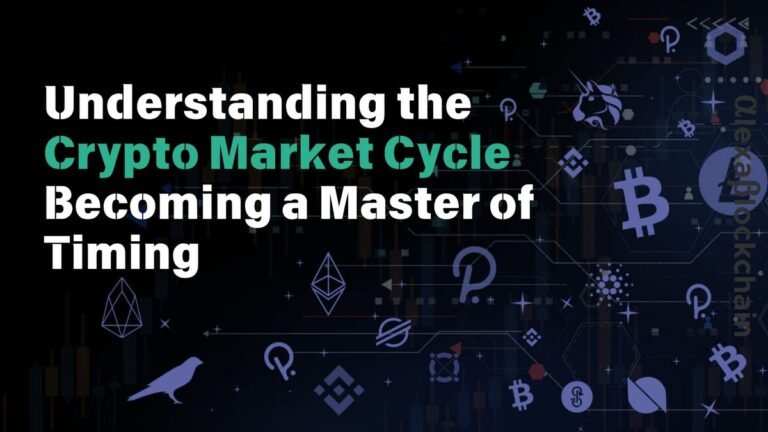According to CoinMarketCap data, the global cryptocurrency market capitalization currently rests at around $2.4 trillion. Given the volatile nature of cryptocurrency, this is of course subject to change every day. But the staggering amount only goes to show how active and involved traders in the crypto market continue to be.
As with any investment venture, however, the crypto market has its own ups and downs. This can be seen in what is known as a cycle, which divides the lifespan of an investment into various stages. For newbie traders who want to know about the best times to sell or buy, here’s a quick overview on the crypto market cycle and how to factor each phase into a trading decision.
The Four Phases of the Crypto Market Cycle
The crypto market cycle typically consists of phases that cover the timeframe from when a cryptocurrency starts gaining steam up to when that interest eventually declines. While there isn’t a way to exactly determine the beginning and end of each cycle, most cryptocurrencies follow this path of evolution.
Knowing the characteristics of each phase can give you an idea of how to better engage with the crypto market. Here are the particulars on the four phases:
1. The Accumulation Phase
This phase is characterized by a lower-than-average market volume since it usually follows a downtrend phase in the general crypto market. At this time, there are no particular trends emerging yet, and given the low price volatility, this is usually the time that crypto investors are encouraged to start accumulating assets—hence the phase name.
Long-term investors will find this phase ideal for them to maximize the buy-and-hold strategy. An example would be to buy Monero (XMR) coins, then storing them in an XMR wallet while monitoring the market instead of trading them right then and there.
The accumulation phase can last from weeks to even years, at least until the market becomes active enough to start the next phase. That means that this phase can be tough on short-term investors, as they may not be able to see decisive shifts in the market yet that will allow them to trade and soon make a profit.
2. The Markup Phase
Building up from the previous phrase, the markup phase is when prices start to rise. This phase usually draws in more investors as well, thus creating a snowball effect that further increases market optimism and trading volume.
Major business entities and the media usually start to give the market more attention during this phase. If you’ve read headlines about the growing crypto market lately, then a significant portion of the market may be in the markup phase.
3. The Distribution Phase
After buying assets thanks to the opportunities presented by the previous phases, some market participants end up selling not long after. In the distribution phase, those buyers-turned-sellers are likely focused on making a profit.
The distribution phase is typically characterized by a high trading volume. However, this phase also marks a potential peak in the market and can be a signal for an upcoming downtrend.
4. The Markdown Phase
As signaled by the aggressive trading from the previous phase, the crypto market cycle then enters the markdown phase. Here, supply starts to exceed demand, and there’s also a downtrend in prices. Panic and anxiety may be charging everyone’s decisions and pressuring more people to sell.
Short sellers usually take advantage of the markdown phase. Eventually, however, the market climate may settle, and so a new crypto market cycle begins anew.
What Affects the Crypto Market Cycle?
There are various factors that affect the start, length, and end of each crypto market cycle. Supply and demand is, of course, a large influence. Political sentiments about crypto and the fiscal policies governing it across countries will factor in, too.
Even the behavior of social media influencers can greatly affect the crypto market cycle. Individuals with large followings can often influence people to buy a certain crypto coin, thus increasing its value.
Trading Decisions You Can Make Across the Crypto Market Cycle
While the market cycle’s duration isn’t set in stone, it’s still a useful reference if you wish to become an active trader. Studying past market cycles can clue you in on future market trends. Likewise, what you learn about the crypto market cycle can also give you assurance as to how to manage your portfolio based on how the market has shifted. Given the markup and markdown phases, for example, you may be able to determine the best time to mix long-term and short-term investments in crypto.
Having deeper knowledge of the crypto market cycle also means you can avoid hasty decisions based on emotions. It may not be as hard to temper your optimism or anxiety over the market performance and, as a result, your decision-making skills about crypto will improve. In the best cases, you’ll be able to avoid missed opportunities to buy and sell when it’s the perfect time to do so.
Now that the cryptocurrency market is on the rise again, more people are starting to participate in it while hoping to cash in on the upward trend. But remember that in any investment venture, timing is of the utmost importance. Let this briefer be a sound guide on the phases of the market cycle and a reference point for when to make the most timely investment decisions.
Read Also: Why Identifying Promising Early-Stage Tokens is Challenging



